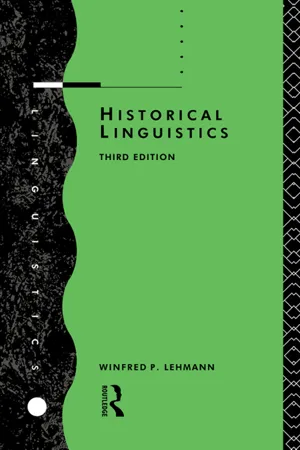Classification
Classification in linguistics refers to the systematic categorization of languages or linguistic elements based on shared characteristics. It involves organizing languages into groups or families to better understand their relationships and historical development. This process helps linguists analyze and compare languages, identify patterns, and make inferences about their origins and evolution.
5 Key excerpts on "Classification"
- eBook - ePub
- David Crystal(Author)
- 2011(Publication Date)
- Wiley-Blackwell(Publisher)
...When its purpose is to focus on the differences between languages, especially in a language-teaching context, it is called contrastive linguistics (see CONTRASTIVE (2)). When its purpose is primarily to identify the common characteristics of different languages or language families, the subject goes under the heading of comparative (or typological) linguistics (see COMPARATIVE (1)). When the emphasis in linguistics is wholly or largely historical, the subject is traditionally referred to as COMPARATIVE PHILOLOGY (or simply PHILOLOGY), though in many parts of the world ‘philologists’ and ‘historical linguists’ are people with very different backgrounds and attitudes. The term structural linguistics is widely used (see STRUCTURAL), sometimes in an extremely specific sense, referring to the particular approaches to SYNTAX and PHONOLOGY current in the 1940s and 1950s, with their emphasis on providing DISCOVERY PROCEDURES for the analysis of a language’s SURFACE STRUCTURE ; sometimes in a more general sense, referring to any SYSTEM of linguistic analysis that attempts to establish explicit systems of RELATIONS between linguistic UNITS in surface structure. When the emphasis in language study is on the Classification of structures and units, without reference to such notions as DEEP STRUCTURE, some linguists, particularly within GENERATIVE grammar, talk pejoratively of taxonomic linguistics. In the later twentieth century the term linguistic sciences came to be used by many as a single label for both linguistics and PHONETICS – the latter being considered here as a strictly pre-language study...
- eBook - ePub
Language, Culture, and Society
An Introduction to Linguistic Anthropology
- James Stanlaw, Nobuko Adachi, Zdenek Salzmann(Authors)
- 2018(Publication Date)
- Routledge(Publisher)
...8 Language Through Time LEARNING OBJECTIVES • Explain the various ways languages are classified. • Name some of the features of language typology. • Describe some of the regularities of sound changes. • Describe some of the processes of vocabulary change. • Be able to do reconstructions of some protolanguage forms. The structure of a language may be analyzed and described as it exists at some point in time, either in the present or the past. The approach that considers a language as though it had been sliced through time, ignoring historical antecedents, is referred to as synchronic linguistics. But it is also possible to study the historical development of a language by giving attention to the changes that occurred in the language over a period of time. Such an analysis or approach is diachronic, or historical, linguistics. This chapter shows some of the ways a diachronic approach can benefit anthropologists. HOW LANGUAGES ARE CLASSIFIED Anyone who knows Spanish will tell you that other languages, such as Portuguese or Italian, seem to be related to Spanish. This is due to their common origin from Latin. Traditionally, one of the most common activities in historical linguistics has been to classify languages according to these genetic relationships. It is difficult to give the exact number of languages spoken in the world at present, but the total undoubtedly approaches 6,000 (Krauss 1992:5–6), possibly 7,000. It is impossible to guess how many languages must have become extinct in prehistoric times. We do know that during the historical period for which we have written records, a great many languages have died out. Language Families A language family includes all those languages that are related by virtue of having descended from a single ancestral language...
- eBook - ePub
Syntactic Analysis
The Basics
- Nicholas Sobin(Author)
- 2010(Publication Date)
- Wiley-Blackwell(Publisher)
...Chapter 2 The Structure and Classification of Words 2.1 The Problem of Word Classification Before discussing syntax, it is important to have some notion of what sorts of words exist. This is so because syntax is about the formation of sentences from words and, with a moment's reflection, you will quickly realize that when you're forming a sentence, the words can't just go anywhere – they seem to have to go in particular places relative to each other. The fact that word positioning is very limited indicates that there are word classes, groupings of words differentiated by sentence position. When speakers “know” a language, a part of what they know is the vocabulary of that language. Let's refer to this mental dictionary as the lexicon of the language. Further, let's refer to the various word classes as lexical categories, since it is membership in one or another such category that dictates where a word can appear in a sentence. A problem that is preliminary to doing any syntactic analysis at all is that of discovering what the various lexical categories are, and which words belong in which category. Traditional grammars of English approach this problem in the discussion of what they usually term “parts of speech.” In what follows, we'll have a look at the traditional view and why it fails. Then we'll go on to establishing more viable grounds for cataloging words into lexical categories. 2.2 The “Traditional” Approach Traditional classroom grammars of English often group the words of English into the eight categories in (1): 1. Typical “8” parts-of-speech list Noun, pronoun, verb, adjective, adverb, preposition, conjunction, interjection. How do we know which words of English belong in which category? The Little, Brown Handbook, like many traditional texts, offers the characterizations in (2) of some of the categories. 2. Traditional definitions of parts of speech (The Little, Brown Handbook (Fowler 1983)) Nouns name. …...
- eBook - ePub
Historical Linguistics
An Introduction
- Winfred P. Lehmann(Author)
- 2013(Publication Date)
- Routledge(Publisher)
...5 Typological Classification 5.1 AIMS OF TYPOLOGICAL Classification Languages may be classified on a totally different basis from that used to determine genealogical relationship, that is, by attention to their type. In typological Classification, selected features may be used to sort out languages, or for that matter any items of human culture, such as tools or social systems, for example, those employed in kinship systems. Linguistic Classification by types has the advantage that a language of any period may be sorted into a specific group; languages attested only today can be so treated, as well as languages attested several millennia ago. Moreover, it has become clear that determination of types provides understanding of the structure of a given language. It is also obvious that such understanding is in accordance with the bases selected for typological Classification. Over the past three and more centuries different bases have been selected, and different procedures have been employed, with gradual improvement in methods and results. Identification of selected characteristics grew out of the attention to languages of the nonwestern world during the seventeenth and eighteenth centuries. As noted above, these reached their culmination in Adelung’s Mithridates (1806–16). When we examine its Classification, we note that it sorts languages into two types: monosyllabic and polysyllabic. Chinese is the first of the monosyllabic languages to be presented by Adelung; of the many polysyllabic languages we may compare his treatment of Turkish. For each, Adelung includes statements on phonology, as that Chinese has no final consonants other than nasals and that it has tones, while Turkish has many phonological elements and generally places the accent on the last syllable of words. Further, that Chinese is uninflected, while Turkish has six cases...
- eBook - ePub
How to Study Linguistics
A Guide to Understanding Language
- Geoffrey Finch, Martin Coyle, John Peck(Authors)
- 2017(Publication Date)
- Bloomsbury Academic(Publisher)
...6 Studying Linguistics Further 6.1 Introduction We have now looked at the three main levels of linguistics: phonology, syntax, and semantics. Let me remind you what these are. Phonology is concerned with the sound structure of the language, in particular with the way in which sounds can form words. Syntax explores the organisation of these words into units such as phrases and sentences. And semantics examines the ability of words to signal meaning through the relationships they have with each other, and with the world of experience. Taken together, these levels constitute what we have termed the grammar of the language. Each is governed by a set of rules, or principles, and in Chapters 3, 4, and 5 we have examined some of the ways in which linguists attempt to describe these. As Jean Aitchison puts it in Teach Yourself Linguistics (1992, p. 8), they constitute the ‘bread and butter’ of linguistics. We can represent this grammatical model in the following way: F IGURE 6.1 There are two other points which I hope have emerged from our discussion so far. First, these three levels are not isolable areas of the language. None of them could exist without the others. And second, the system is not watertight. Words circulate all the time through the linguistic system, like blood around the body. But at every stage of their existence they are constantly being renewed by transfusions from the non-linguistic world. These transfusions might be phonological – words can change their pronunciation form; or syntactic – words may change their class, for example, nouns may become verbs; or semantic – words may change their meaning. It is a dynamic not a static system. And because of that, we have identified in each case a more abstract, and a more concrete, dimension of these levels...




